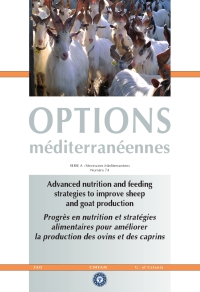| Article précédent | p. 345-350 | Article suivant |
Effect of the concentrate source on milk yield, milk composition and feeding behaviour of grazing sheep during summer season
The trial was carried out on 40 Sardinian grazing sheep divided into four groups of 10 each, during the summer season. The animals of indoor group (S) were fed with vetch-oats hay and commercial concentrate; group (P) was fed only at pasture; group (PR) was fed with pasture and highly degradable concentrate (barley grain and chick-pea); group (PL) was fed with pasture and lowly degradable concentrate (maize and broad bean). Weekly milk yield, body weight and body condition score (BCS) were recorded and milk and blood samples were collected. The sheep behaviour was monitored with scan sampling method. The grazing behaviour was different between groups; P group spent longer feeding on pasture (80%), expressed as percentage of total observation time, than the PR and PL groups (42% and 38% respectively). Milk yield of PL group was higher (P<0.05) than P and PR groups (1.32 kg, 0.92, 1.06 respectively), while no significant differences were observed between PL group and S group. Milk protein, fat, lactose and curd firmness were affected by the nutritional treatments. Keywords: Grazing, sheep, concentrate, feeding behaviour, milk yield.
L'objectif de cette expérience était d'étudier l'influence de différents types de complémentation (concentrés à vitesse de dégradation plus ou moins élevée) sur la production et la qualité du lait et le comportement alimentaire d'ovins au pâturage. L'expérience a été réalisée au cours de l'été, avec 4 groupes comparables de 10 brebis Sardes, en milieu de lactation, pâturant une prairie naturelle de plaine. Les brebis ont été alimentées selon les modalités suivantes : groupe S (en bergerie avec foin ad libitum et 700 g/j de concentré commercial), groupe PS (pâturage seulement pendant 8 h/j), groupe PR (pâturage plus 700 g/j d'orge et pois chiche), groupe PL (pâturage plus 700 g/j de maïs et féverole). Les groupes au pâturage ont montré un comportement alimentaire différent. Le groupe PS a montré un temps élevé de broutement (80%), exprimé en pourcentage du temps total d'observation, par rapport aux groupes PR et PL (42% et 38% respectivement). La production laitière la plus élevée a été enregistrée dans le groupe PL (1,32 kg) (P<0,05) contre 0,92 kg et 1,06 kg dans les groupes PS et PR respectivement. Entre les groupes PL et S, au contraire, des différences significatives n'ont pas été observées. Au niveau qualitatif, des différences ont été observées pour la matière azotée, le taux butyrique, le lactose et la consistance du coagulum. Les différents types de complémentation, en conclusion, ont modifié le comportement alimentaire, la production et la qualité du lait.
- [ Afficher ]
- [ Télécharger ]
- [ Exporter la citation ]
Vous pouvez télécharger la citation au format :
- [ Imprimer ]
-
Mots-clés
BREBIS, COMPLEMENT ALIMENTAIRE, COMPORTEMENT ALIMENTAIRE, EXPERIMENTATION, LAIT, PATURAGE, PRODUCTION LAITIERE, QUALITECiter cet article
Annicchiarico G., Claps S., Marino R., Terzano G., Caternolo G., Taibi L. Effect of the concentrate source on milk yield, milk composition and feeding behaviour of grazing sheep during summer season. In : Priolo A. (ed.), Biondi L. (ed.), Ben Salem H. (ed.), Morand-Fehr P. (ed.). Advanced nutrition and feeding strategies to improve sheep and goat . Zaragoza : CIHEAM, 2007. p. 345-350. (Options Méditerranéennes : Série A. Séminaires Méditerranéens; n. 74). 11. Seminar of the FAO-CIHEAM Sub-Network on Sheep and Goat Nutrition, 2005/09/08-10, Catania (Italy). http://om.ciheam.org/om/pdf/a74/00800400.pdf



